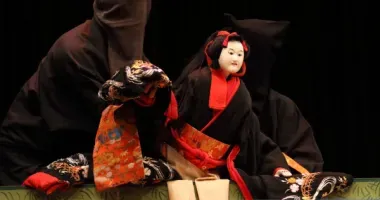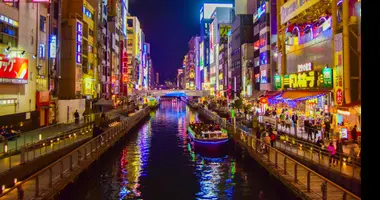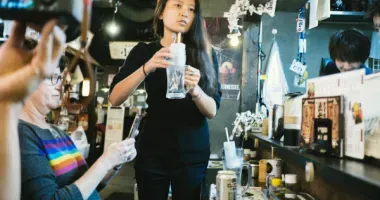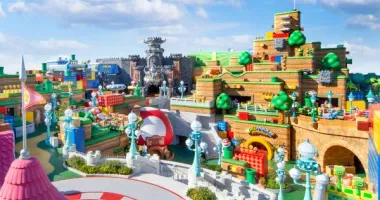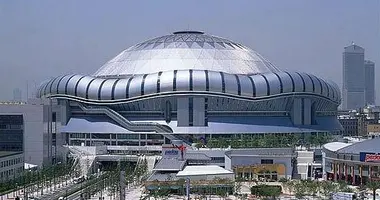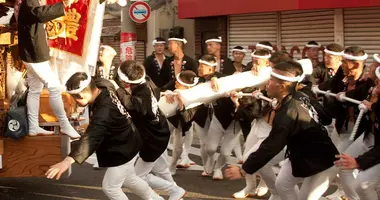Tenjin Matsuri (Tenjin Festival) Osaka
Tenjin Matsuri Osaka - 天神際
Alan Wiren
Dates: 24-25 July, 2019
The story of Tenjin Matsuri runs backward and forward from the moment a man was made a god. In life he was Sugawara no Michizane. The son of a school owner, born in the ninth century, he excelled in academics and poetry. Politics would be his downfall.

Tenjin Matsuri, Osaka

Miko Shrine Maidens, Tenjin Matsuri, Osaka
Sugawara no Michizane
He joined the court in the ninth century at the beginnings of the Fujiwara clan's climb to power and rose rapidly with it. Within seven years he held high rank and had served in the ministries of Civil Affairs, War, and Popular Affairs.
His assignment to the Ministry of the Ceremonial gave him broad influence over educational matters. And he would eventually be granted the highest professional office at the academy founded by his father which he had, by that time, taken over.
Then the stream of politics began to ripple. Emperor Uda ascended putting the roles of the most highly placed Fujiwara in doubt. Nonetheless Michizane stayed afloat. He was favored by Uda and, in time, held the rank of Assistant Master of the Crown Prince's Household.
That was when fate struck. The Fujiwaras bolstered their position, Uda abdicated and Michizane was demoted in rank. At the opening of the tenth century he was exiled to a backwater province on the island of Kyushu where he would end his days in ignominy.

Tenjin Festival, Kita-ku, Osaka

Tenjin Festival, Kita-ku, Osaka
Plague & Misfortune
Following on the heels of Michizane's demise came misfortune and tragedy. Floods, plague, and drought ravaged the country. The sun eclipsed. The imperial palace was struck by lightening. Middle ranking and high officials, even princes, died. Their ghostly fingers pointed to the vengeful spirit of Michizane. Four decades later emperor Sukazu gave in and built the first Tenmangu Shrine, Kitano Tenmangu in Kyoto, dedicating it to Michizane.
The shrine was patronized by the next emperor, Murakami. Not enough; ill fortune still abounded in Japan. So it was that Michizane became the first human being in Japan to be apotheosized. To calm his relentless spirit he was declared Temman-Tenjin, kami of scholarship. Today the number of Temmangu shrines, all dedicated to Tenjin, is estimated to be over 1,200.
Osaka's Temmangu Shrine was founded two years after Kitano Temmangu, in 949. It was to become the center of Tenjin Matsuri Osaka's largest and most well known festival. Fast forward a scant two years to a long hot summer, remembering that in the time before antibiotics, the spread of disease was an inescapable, mortal threat, amplified by fatigue. The people of Osaka turned to Kami Tenjin for protection.
Osaka's Temmangu is not far from the Dojima River. In its origin Tenjin Matsuri may have involved carrying paper dolls in human form to the shrine which were prayed over by the priests and then brought to the river to be thrown overboard from boats, to rid the city folk of evil spirits.

Shindo (holy child), Tenjin Festival, Kita-ku, Osaka

The Tenjin Festival takes place both on land and water, Kita-ku, Osaka
Procession
The ceremony that initiates Tenjin Matsuri in modern times still begins with a procession to the river and centers on a tradition that is well over a thousand years old.
Every 24th of July, around 8.30 am you can hear the voices of a contingent of around 200 monks raised in prayer at the temple. They then proceed across the dusty court and through the main gate, in the company of a crowd of lay-people, escorting a child chosen as the shindo (holy child). The shindo wears an elaborate kimono, his face is made up, and he carries the sacred halberd. The latter is symbolic: shaped like a curved sword, it is carved from a buoyant wood.
When the bridge, Hokonagashi, is reached the VIPs settle down in reserved seating in the shadow of a large, stone gate typical of the entrances to Japanese Shinto shrines. Here a ceremony including many of the city's dignitaries and organizations is performed. Even the Boy Scouts get involved.
Meanwhile a white boat with bamboo trees mounted like masts fore and aft bobs on the river below. When the dancing and chanting finish, the shindo is brought down to board the boat with its pilot. The craft sets out into the middle of the river where the halberd is laid upon the waters with a similar effect to that the dolls may once have had.
The crowd disperses. The mood of the city returns almost to normal. Almost. But stroll along the river. The parks and the streets there are filling up with temporary vendors of all descriptions: foods, amusements for young and old, trinkets and souvenirs. They are selling now to casual passersby, but everyone knows this is a lull before the festival starts in earnest.

Taiko drum, Tenjin Festival, Kita-ku, Osaka

Mooyoshi Daiko, Tenjin Festival, Kita-ku, Osaka
Mooyoshi Daiko
What issues next from Temmangu is the Mooyoshi Daiko at 4pm. It is a huge drum (actually an identical pair, used in turn) on a float that carries a team of 8 drummers. Some say the drum was donated to the shrine by Osaka's founder, Toyotomi Hideyoshi.
It is paraded through the surrounding streets, with fanfare and its booming voice, in a performance that is as much theater as music. Follow the drum and you will soon discover that this is a festival of both land and water. You will come across other processions making music, dancing, parading in fantastic costume.
There are myriad local groups and the streets are lined with onlookers. In the river, dondoko boats appear unpredictably, continuously playing, on gongs and drums, the rhythm echoed in their name. Meanwhile, in the shrine, booths have appeared displaying traditional activities and art, or selling charms.
And this has been merely the prelude.

Tenjin Festival, Kita-ku, Osaka

Tenjin Festival Boat, Kita-ku, Osaka
Lanterns
It is not until about 3pm on the next day that things get rolling again. Then processions including thousands issue from the shrine. The vendors have all staked their places. As the sun goes down a new theme of light and darkness becomes apparent. Lanterns burn along the banks of the river. At six o'clock portable shrines with lanterns of their own emerge from the shrine gate.
They go in a straight line to the river and are boarded onto boats as the waterborne procession commences. It carries Tenjin's divine spirit along the river to be met by another flotilla coming from the opposite direction. A solemn, Shinto ritual is performed along with Noh performances while a background of fireworks makes for a panoramic contrast of the elements.
By the time the climax comes on the water, the streets have flooded with people - and this is, arguably, the festival's most intrinsic theme. Young women in elegant kimono, quaffed, and besparkled with jewelry, many on the arms of young men. Families, cohorts from school or work flowing through parks, the vendors hawking, all out together, celebrating the night.
And then they all return, like the universe folding back into Buddha's navel. The boats complete their circuit. The icons and performers travel overland back to the shrine. Close to midnight they usher in through the gate while the drums and gongs keep up the dondoko rhythm. The streets gradually empty. It is finished - until next year.

Tenjin Festival, Kita-ku, Osaka
Access - how to get to Tenmangu Shrine, Osaka
Tenjin Shrine
Tenjinbashi, 2-1-8, Kita-ku
Osaka 530-0041
Tel: 06 6353 0025
Access: Tenmangu Shrine is close to Exit 4 of Minamimori-machi Station on the Tanimachi Line and Sakaisuji Line of the Osaka subway.
Alternatively take a Tozai Line train to JR Tenmangu Station and take exit 3 for the Tenjinbashi shopping street.
Tenjin Matsuri takes place on the 24 and 25 July each year.
Books on Osaka
Recommended books on Osaka include the Offbeat Guide to Osaka and Exploring Osaka: Japan's Second City by David M. Dunfield.
Books on Japan
Tenjin Matsuri (天神際) is one of Osaka's largest and most colorful festivals. Tenjin Festival takes place annually on July 24 and July 25 around Tenjin Shrine.
